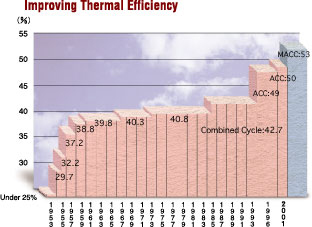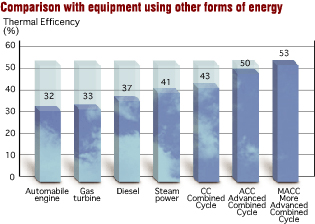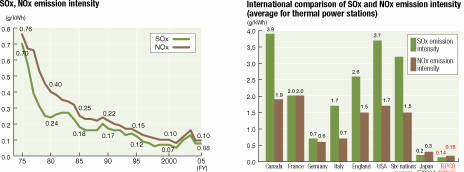
Each 1% improvement in the thermal efficiency of a thermal power station translates into an annual saving of some 670,000 kl of heavy oil and a yearly reduction of some 1.5 million tons of carbon dioxide (CO2) generated at TEPCO alone.
From the mid-1950s to the mid-1960s, the thermal efficiency of thermal power generation facilities stood at 30%. Subsequent technological advances have enabled the latest ACC power generation facilities to achieve a thermal efficiency of 50% today, a level which ranks among the highest in the world.

TEPCO's thermal power stations consist of large-scale, high-efficiency power generation facilities that utilize the latest technology and scale merit to the full extent. As a result, compared with the small-sized co-generation facilities, the thermal efficiency (ratio of the energy of the fuel used to the electrical output) of these power stations is much higher. In general, the thermal efficiency of co-generation facilities is high on condition than the demand ratio of electricity and heat are constant.
Toxic Substance Emissions Slashed by Company's Own Efforts
Burning coal, oil, and other fossil fuels produces nitrogenous compounds (NOx) and sulfur oxides (SOx). TEPCO has an ongoing program to protect the environment by, for instance, installing denitrification facilities and electrostatic precipitators, and by introducing LNG and other environmentally friendly fuels. As a result of such efforts, it has achieved discharge levels that are among the lowest in the world.
Even carbon dioxide (CO2) emission, which is considered to have a major impact on global warming, has been cut to a low emission rate level by the company's moves to improve the thermal efficiency of its thermal power plants.

© Tokyo Electric Power Company Holdings, Inc.